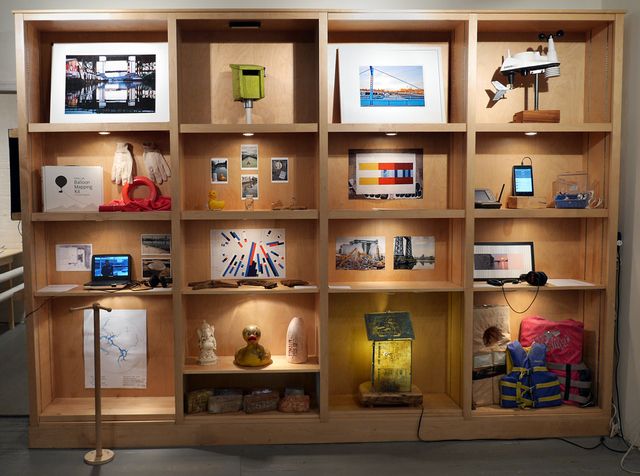Last-Minute NYC Holiday Gift Guide 🎁
We’ve created a holiday gift guide with presents for the intrepid New Yorker that should arrive just in time—


Newtown Creek Armada commissioned remote control boats to document the creek up close
New York City—as we are reminded every time there is a heavy rain event—uses a combined sewer system. This means sewage and storm-water runoff share a collection pipe and are both treated at a wastewater treatment facility before being discharged to the ocean. During heavy rainfall however, the system cannot cope, and excess storm-water, with household sewage, is rerouted directly into the ocean without treatment, in what is known as a combined sewer overflow, or CSO. During a CSO, beaches are closed, algae blooms, and the city’s waterways exude a distinct—some would say repellent—scent.
Last Friday’s rainfall marked such an event, so it was an appropriate time to visit “Combined Overflow,” an exhibition at Brooklyn’s Proteus Gowanus celebrating several artists’ musings on two of New York City’s most polluted waterways: the Gowanus Canal and Newtown Creek.
The exhibition features a wide range of mediums, from Eymund Diegel‘s sculptures made of flotsam, to Jenifer Wightman‘s photographs of the colorful bacterial transmutations of a sample of toxic sludge. Many are not just visually appealing but also include potentially useful information collected from the water, like maps of the locations and types of wreckage salvaged from the bottom of Newtown Creek, geo-tagged data from the Gowanus Canal, including pH levels, oxygen content and temperature, and an underwater video of the canal’s radioactive-green muck, a feat that could not be safely conducted by a human.
The Gowanus Canal and Newtown Creek were both deemed federal “Superfund” sites in 2010. Superfund designation empowers the US Environmental Protection Agency to clean up hazardous waste sites and compel responsible parties to foot the bill. Beginning in the mid-19th century, the waterways’ banks were lined with slaughterhouses, casket factories, oil refineries, steel recycling plants, and other businesses that found the streams a convenient place to dump their waste. The steady decline of heavy industry in New York City precipitated a corresponding decline in new sources of waste, but the waters are largely sedentary, so old waste can fester for a long time.
As in other parts of the city, the void left by shuttered manufacturers has been filled with newcomers, drawn to the bright, open warehouses in neighborhoods like Greenpoint and Gowanus. The presence of artists has attracted trappings like rock-climbing gyms, shuffleboard bars, Whole Foods, and—inevitably—developer interest. The Lightstone Group has a 700-unit rental complex under construction on the west bank of the Gowanus Canal. Park Tower Group has plans for ten towers up to 40 stories tall on the waterfront where Newtown Creek meets the East River.
Nathan Kensinger, a photographer and one of the curators of “Combined Overflow,” recently documented the before and after of the demolition of a cluster of locally beloved silos on the Lightstone Group site. Existing residents are leery not only of the new crop of housing coming to their backyards, but also of the planned clean-up efforts. While the waterways in their current state aren’t too amenable to recreation and are occasionally smelly, some worry that any major alteration to their ecosystem could dust up long-buried toxins, threatening not just the safety of the water itself, but potentially nearby air as well.

The boats are made from flotsam collected from the water
In part, “Combined Overflow” was designed to show that despite their history of pollution and as the brunt of local jokes, Newtown Creek and the Gowanus Canal are actually more hospitable, navigable, and even livable, than many think. There is now a publicly accessible park on the grounds of the Newtown Creek Wastewater Treatment Plant. The North Brooklyn Boat Club organizes regular canoe and kayak excursions on Newtown Creek (and overnight ones circumnavigating Manhattan). Since the 1990s, more and more flora and fauna have been spotted in and around the Gowanus, including saltwater turtles, horseshoe crabs and Canadian geese. (Sadly, whales and dolphins haven’t been so lucky.)
In coming years, more and more residents will be lured to their shores, the federal government will embark on a slow, expensive remediation effort, and Mother Nature will periodically show her wrath. While their waters are stagnant, the city around them is anything but, and we should be grateful we have these artists and scientists to document the changes.

Maps, photos and found objects are on display in the exhibition
“Combined Overflow” is on view until Saturday at Proteus Gowanus, 543 Union St., Brooklyn
Photos courtesy of Newtown Creek Armada, except where otherwise noted.
Subscribe to our newsletter